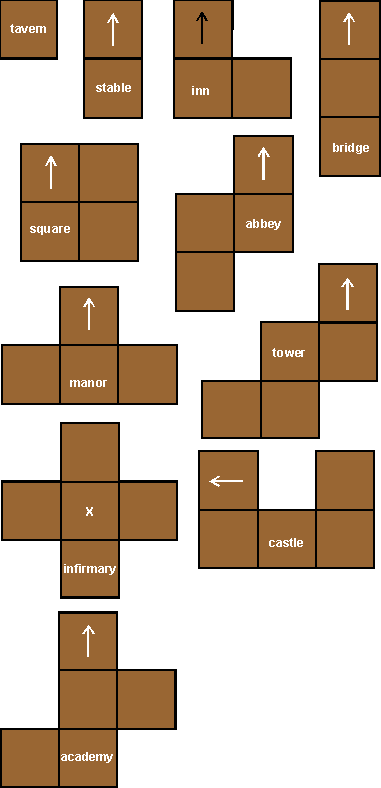We have been asked many times if there
are any electronic or online play options available for "Cathedral, the Game of the Mediaeval City".
There are no electronic or genuine internet versions available at the moment.
Alternatively one could play across the internet via e-mail, Messenger, or discussion group if there was a suitable notation such
as
exists for Chess. In response to this request came up with a workable
language that you can set up in a moment and learn in even less time. This page
has the instructions on how to do so. With the advent of Facetime and Zoom it's also possible to play in real time, even with only one board and the person who hasthe board places the pieces. Great for overcoming Covid related boredom if you are in seperate bubbles.
CATHEDRAL, PLAY NOTATION
The Problem: In terms of notation Cathedral presents a problem that does not exist in Chess. Chess is two dimensional , each piece covers one square, each square has one name, identify the piece you wish to move and name the square you wish to move it to. Cathedral on the other hand is three dimensional. You must first name the piece you wish to place, align it with the game board in the direction you wish it to face, then locate it on the chosen squares.
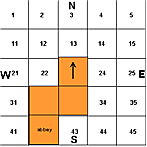 First
name the playing surface. Create a 10x10 grid to fit over the normal game board
surface. Number the squares A1 to J10 from top left to bottom right, Mark the
top = north, bottom = south, left = west
and right = east. Label the top of the playing surface A - J and the left 1 - 10. On
each piece now adhere by some means a compass needle on the segment indicated
(as shown below ) white
labels or masking tape. The compass aligns the piece in the chosen direction,
and also locates the playing piece. To solve the question of which segment
of the piece covers the chosen square the segment which has the compass arrow
(called the prime square) adhered to it
is the datum or location segment the whole piece rotates about this segment
and this segment covers the chosen square. The animation to the right demonstrates
this principle.
First
name the playing surface. Create a 10x10 grid to fit over the normal game board
surface. Number the squares A1 to J10 from top left to bottom right, Mark the
top = north, bottom = south, left = west
and right = east. Label the top of the playing surface A - J and the left 1 - 10. On
each piece now adhere by some means a compass needle on the segment indicated
(as shown below ) white
labels or masking tape. The compass aligns the piece in the chosen direction,
and also locates the playing piece. To solve the question of which segment
of the piece covers the chosen square the segment which has the compass arrow
(called the prime square) adhered to it
is the datum or location segment the whole piece rotates about this segment
and this segment covers the chosen square. The animation to the right demonstrates
this principle.
Example of the playing Grid:-
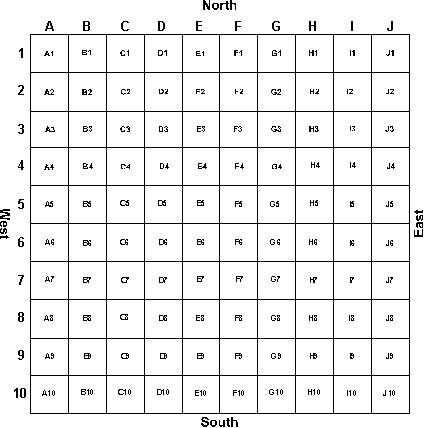
You can print this grid to use over your game board by clicking on the image or HERE
Mark the pieces thus:- Using a felt tip pen mark all the pieces with a compass arrow on the segments shown below and in the corresponding direction (alternately you might use white stickers if you do not wish to permanently mark your pieces). Remember the Dark Abbey and Dark Academy are mirror images of light pieces shown below.
The Cathedral
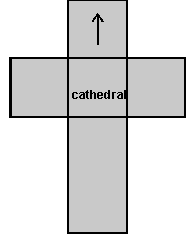
The Pieces
DARK
Example of Play, using e-mail, text, chat or phone :-
The Cathedral is positioned first. In this case the player has positioned the Cathedral facing north, and the arrow (prime square) covering square E5.
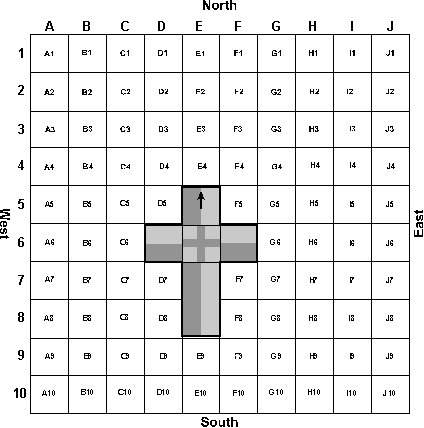
The second player has chosen to place the Castle next to the Cathedral as seen below. The Castle is facing East and the prime square (compass arrow) is covering F5. Play may continue in this manner, naming the Piece the Direction and the Location.
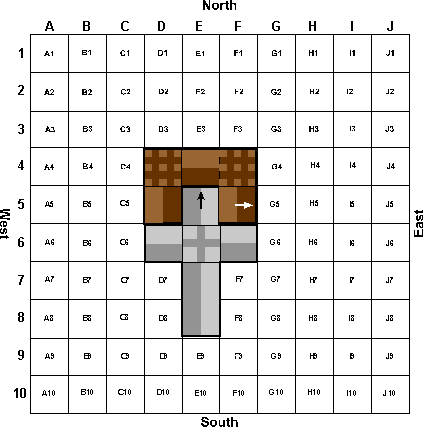
The Notation would read thus:-
| Move | Piece | Direction | Location |
| 1 | Cathedral | N | E5 |
| 2 | Light Castle | E | F5 |
See if you can place the next move, click here for the solution.
| Move | Piece | Direction | Location |
| 3 | Dark Tower | W | G5 |
A True Notation
Taking this a step further, it is possible to abbreviate the names
of the pieces and the play notation thus:
CA:
TA:
ST:
IN:
BR:
SQ:
MA:
AB:
IF:
CS:
TO:
AC:
N:
E:
S:
W:Cathedral
Tavern
Stable
Inn
Bridge
Square
Manor
Abbey
Infirmary*
Castle*
Tower
Academy
North
South
East
West
A game above would then consist of the following notation
1.
2.DARK
CAnE5
TOwG5LIGHT
CSeF5
etc.CAnE5 = Cathedral, north, square E5
We trust you will enjoy playing Cathedral remotely by this mehod. Let us now if it works for you or if it can be improved, your comments and suggestions are welcome.
Acknowledgements:
Dave Perkins, for insisting on an alphanumeric layout and test playing
the language.
Mike Donovan, for suggesting abbreviation of the notation structure as
in the last table above.


